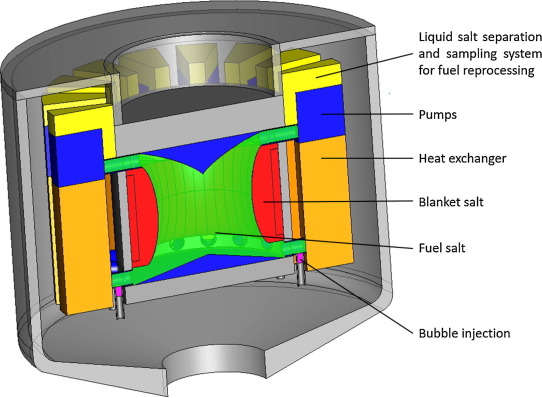当前位置:
X-MOL 学术
›
Chem. Eng. Sci.
›
论文详情
Our official English website, www.x-mol.net, welcomes your feedback! (Note: you will need to create a separate account there.)
Development of a multiphysics model for the study of fuel compressibility effects in the Molten Salt Fast Reactor
Chemical Engineering Science ( IF 4.7 ) Pub Date : 2019-01-01 , DOI: 10.1016/j.ces.2018.09.025 E. Cervi , S. Lorenzi , A. Cammi , L. Luzzi
Chemical Engineering Science ( IF 4.7 ) Pub Date : 2019-01-01 , DOI: 10.1016/j.ces.2018.09.025 E. Cervi , S. Lorenzi , A. Cammi , L. Luzzi

|
Abstract Compressible fluid dynamics is of great practical interest in many industrial applications, ranging from chemistry to aeronautical industry, and to nuclear field as well. At the same time, modelling and simulation of compressible flows is a very complex task, requiring the development of specific approaches, in order to describe the effect of pressure on the fluid velocity field. Compressibility effects become even more important in the study of two-phase flows, due to the presence of a gaseous phase. In addition, compressibility is also expected to have a significant impact on other physics, such as chemical or nuclear reactions occurring in the mixture. In this perspective, multiphysics represents a useful approach to address this complex problem, providing a way to catch all the different physics that come into play as well as the coupling between them. In this work, a multiphysics model is developed for the analysis of the generation IV Molten Salt Fast Reactor (MSFR), with a specific focus on the compressibility effects of the fluid that acts as fuel in the reactor. The fuel mixture compressibility is expected to have an important effect on the system dynamics, especially in very rapid super-prompt-critical transients. In addition, the presence of a helium bubbling system used for online fission product removal could modify the fuel mixture compressibility, further affecting the system transient behaviour. Therefore, the MSFR represents an application of concrete interest, inherent to the analysis of compressibility effects and to the development of suitable modelling approaches. An OpenFOAM solver is developed to handle the fuel compressibility, the presence of gas bubbles in the reactor as well as the coupling between the system neutronics and fluid dynamics. The outcomes of this analysis point out that the fuel compressibility plays a crucial role in the evolution of fast transients, introducing delays in the expansion feedbacks that strongly affect the system dynamics. Moreover, it is found that the gas bubbles significantly alter the fuel compressibility, yielding even larger differences compared to the incompressible approximation usually adopted in the current MSFR solvers.
中文翻译:

开发用于研究熔盐快堆中燃料压缩性效应的多物理场模型
摘要 可压缩流体动力学在许多工业应用中具有重要的实际意义,从化学到航空工业,再到核领域。同时,可压缩流动的建模和模拟是一项非常复杂的任务,需要开发特定的方法,以描述压力对流体速度场的影响。由于存在气相,在两相流动的研究中,可压缩性的影响变得更加重要。此外,预计可压缩性也会对其他物理学产生重大影响,例如混合物中发生的化学或核反应。从这个角度来看,多物理场代表了解决这一复杂问题的有用方法,提供一种方法来捕捉所有起作用的不同物理以及它们之间的耦合。在这项工作中,开发了一个多物理场模型,用于分析第四代熔盐快堆 (MSFR),特别关注在反应堆中充当燃料的流体的可压缩性效应。预计燃料混合物的可压缩性会对系统动力学产生重要影响,尤其是在非常快速的超快速临界瞬态中。此外,用于在线裂变产物去除的氦气鼓泡系统的存在可能会改变燃料混合物的可压缩性,进一步影响系统瞬态行为。因此,MSFR 代表了一种具体利益的应用,它是分析可压缩性效应和开发合适的建模方法所固有的。开发了 OpenFOAM 求解器来处理燃料可压缩性、反应堆中气泡的存在以及系统中子学和流体动力学之间的耦合。该分析的结果指出,燃料可压缩性在快速瞬变的演变中起着至关重要的作用,在膨胀反馈中引入了对系统动力学产生强烈影响的延迟。此外,发现气泡显着改变了燃料的可压缩性,与当前 MSFR 求解器中通常采用的不可压缩近似相比,产生了更大的差异。该分析的结果指出,燃料可压缩性在快速瞬变的演变中起着至关重要的作用,在膨胀反馈中引入了对系统动力学产生强烈影响的延迟。此外,发现气泡显着改变了燃料的可压缩性,与当前 MSFR 求解器中通常采用的不可压缩近似相比,产生了更大的差异。该分析的结果指出,燃料可压缩性在快速瞬变的演变中起着至关重要的作用,在膨胀反馈中引入了对系统动力学产生强烈影响的延迟。此外,发现气泡显着改变了燃料的可压缩性,与当前 MSFR 求解器中通常采用的不可压缩近似相比,产生了更大的差异。
更新日期:2019-01-01
中文翻译:

开发用于研究熔盐快堆中燃料压缩性效应的多物理场模型
摘要 可压缩流体动力学在许多工业应用中具有重要的实际意义,从化学到航空工业,再到核领域。同时,可压缩流动的建模和模拟是一项非常复杂的任务,需要开发特定的方法,以描述压力对流体速度场的影响。由于存在气相,在两相流动的研究中,可压缩性的影响变得更加重要。此外,预计可压缩性也会对其他物理学产生重大影响,例如混合物中发生的化学或核反应。从这个角度来看,多物理场代表了解决这一复杂问题的有用方法,提供一种方法来捕捉所有起作用的不同物理以及它们之间的耦合。在这项工作中,开发了一个多物理场模型,用于分析第四代熔盐快堆 (MSFR),特别关注在反应堆中充当燃料的流体的可压缩性效应。预计燃料混合物的可压缩性会对系统动力学产生重要影响,尤其是在非常快速的超快速临界瞬态中。此外,用于在线裂变产物去除的氦气鼓泡系统的存在可能会改变燃料混合物的可压缩性,进一步影响系统瞬态行为。因此,MSFR 代表了一种具体利益的应用,它是分析可压缩性效应和开发合适的建模方法所固有的。开发了 OpenFOAM 求解器来处理燃料可压缩性、反应堆中气泡的存在以及系统中子学和流体动力学之间的耦合。该分析的结果指出,燃料可压缩性在快速瞬变的演变中起着至关重要的作用,在膨胀反馈中引入了对系统动力学产生强烈影响的延迟。此外,发现气泡显着改变了燃料的可压缩性,与当前 MSFR 求解器中通常采用的不可压缩近似相比,产生了更大的差异。该分析的结果指出,燃料可压缩性在快速瞬变的演变中起着至关重要的作用,在膨胀反馈中引入了对系统动力学产生强烈影响的延迟。此外,发现气泡显着改变了燃料的可压缩性,与当前 MSFR 求解器中通常采用的不可压缩近似相比,产生了更大的差异。该分析的结果指出,燃料可压缩性在快速瞬变的演变中起着至关重要的作用,在膨胀反馈中引入了对系统动力学产生强烈影响的延迟。此外,发现气泡显着改变了燃料的可压缩性,与当前 MSFR 求解器中通常采用的不可压缩近似相比,产生了更大的差异。



























 京公网安备 11010802027423号
京公网安备 11010802027423号